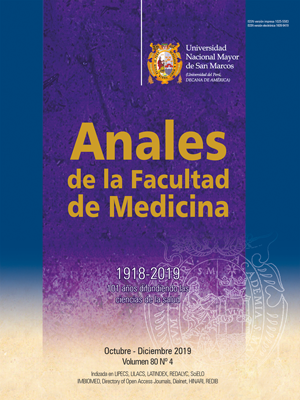Valuation of collaborative work and academic performance in the teaching process of a research course in medical students
DOI:
https://doi.org/10.15381/anales.v80i4.17251Keywords:
Aprendizaje Colaborativo, Rendimiento Académico, Investigación, Cursos, Facultades de MedicinaAbstract
Introduction. Collaborative work promotes learning through active participation of students, allowing the development of social abilities and the construction of their own knowledge. Objective. To analyze collaborative work and its relationship with academic performance in medical students in a research course. Methods. Cross-sectional study, in which 148 human medicine students enrolled in the research course participated, selected using a non-probabilistic sample. The questionnaire called analysis of cooperative work in higher education that assesses the importance of collaborative work, of 49 questions distributed in seven dimensions, was used. A Likert scale was used in a range of 1 to 5, where 1 is valued as a total disagreement and 5 totally agree. Three groups were established: low group to 33 percentile; middle group, from 34th percentile to 66th percentile; and high group, from 67th percentile to more. Results. The average age was 22,4 years and 52,7% corresponded to the female gender. In the “conception of work” dimension, 40,5% of students belonged to the middle group; in the dimension “planning the work of the groups by the teacher”, 41,9% to the low group; in “criteria for organizing groups”, 37,8% for the low group; in “internal operation”, 43,2% to the low group; and in “work efficiency”, 32,4% to the high group and 39,9% to the low group. The global average of grades corresponded to 12,7. The academic performance in students of the low and medium group was similar, and in the female students of the high group it was significantly higher (p=0,049). Conclusions. The low group predominated in the dimensions “teacher’s work planning”, “criteria for organizing groups”, “operating standards”, “internal functioning” and “efficiency”. 54,7% of students corresponded to the high group and the overall grade point average was 12,7. There was no relationship between the variables studied.
Downloads
Published
Issue
Section
License
Copyright (c) 2019 Anales de la Facultad de Medicina

This work is licensed under a Creative Commons Attribution-NonCommercial-ShareAlike 4.0 International License.
Those authors who have publications with this magazine accept the following terms:
- Authors will retain their copyrights and guarantee the journal the right of first publication of their work, which will be simultaneously subject to Creative Commons Attribution License that allows third parties to share the work as long as its author and its first publication this magazine are indicated.
- Authors may adopt other non-exclusive licensing agreements for the distribution of the version of the published work (eg, deposit it in an institutional electronic file or publish it in a monographic volume) provided that the initial publication in this magazine is indicated.
- Authors are allowed and recommended to disseminate their work over the Internet (eg: in institutional telematic archives or on their website) before and during the submission process, which It can produce interesting exchanges and increase quotes from the published work. (See El efecto del acceso abierto ).















